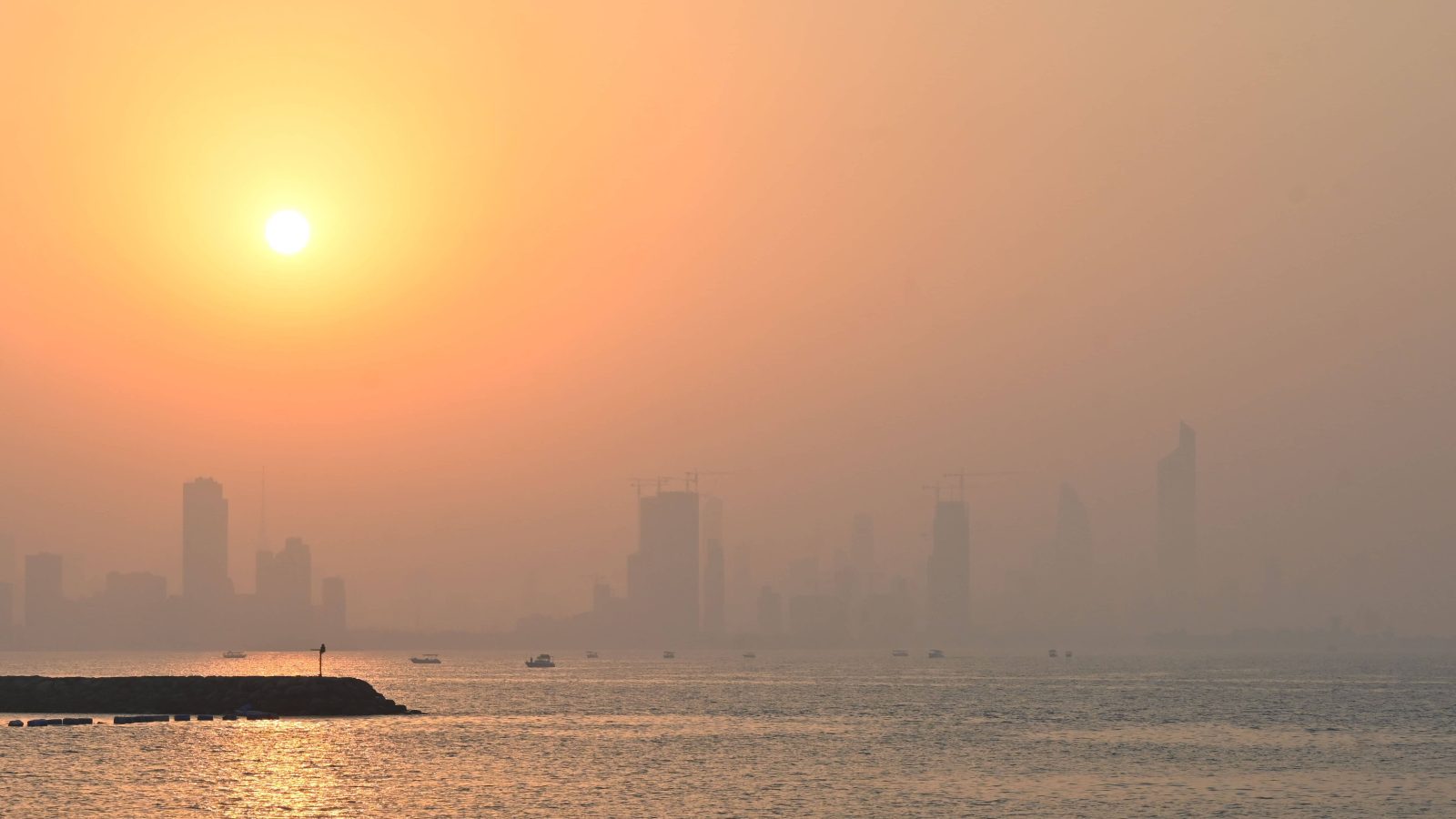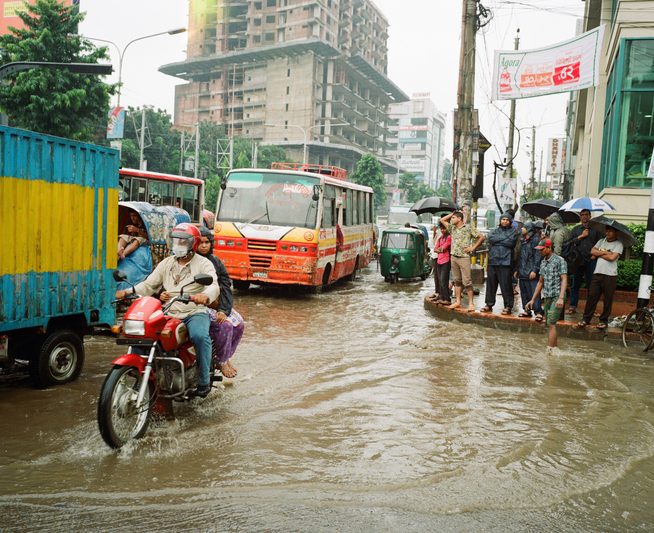This story was originally published by The Guardian and is reproduced here as part of the Climate Desk collaboration.
For Muskan, the arrival of summer in Delhi is the “beginning of hell.” As temperatures in her cramped, densely populated east Delhi neighborhood often soar above 45 degrees Celsius (113 Fahrenheit), she dreams of only one thing: air conditioning.
During the day, in the tiny, windowless kitchen where she cooks for her family, she often feels like she will collapse from the heat and her health deteriorates. Nights are even more painful. Sleep becomes almost impossible in their single-room apartment.
Her three children, sticky and uncomfortable, cry out begging to be cooled down, and she wakes every five minutes to douse them and herself with cold water and wet scarves.
The single fan hanging from the flaking yellow ceiling does little to ease their woes and the putrid stench from the sewage and festering rubbish means opening a window is impossible. In any case, as she points out: “It’s usually even hotter outside.”
In her previous marriage, the 30-year-old had tasted the sweet relief of air conditioning in Delhi’s increasingly blistering summers. But after her husband died, her family remarried her to a scrap dealer, whose earnings are barely enough to pay for rent and food. The costs involved in renting or buying an air conditioner (AC) are far beyond their means, yet she fears for her family without one.
“I can’t keep seeing my children suffer like this,” she says. “I keep promising that next summer we will get an AC but the reality is I know we can’t afford it. But as more and more people around us buy ACs, the hotter it gets outside. Soon, I don’t know how we will survive.”
India’s market for ACs is growing faster than almost anywhere else in the world. A mixture of rising incomes, rising temperatures in an already hot and humid climate, and increasing affordability and access are driving more and more Indians towards buying or renting one as soon as they can afford it – and sometimes even when they cannot.
Between 8 percent and 10 percent of the country’s 300 million households – home to 1.4 billion people – have an AC, but that number is expected to hit close to 50 percent by 2037, according to government projections. A report by the International Energy Agency (IEA) predicts that by 2050, India will have more than 1 billion ACs in operation.
Vaibhav Chaturvedi, a fellow at the council on energy, environment and water, a Delhi thinktank, was among those who believed AC penetration would exceed all current predictions.
“Traditionally, air conditioning was viewed as a luxury commodity but not any more,” he said. “It is seen as a necessity to survive. The way the market is developing, it could be that 100 percent of households have AC by 2050.”
Others are more sceptical that ACs will become so widespread among India’s poor people, and have raised concerns that access to sufficient cooling, particularly to work, sleep, and stay healthy, could drive up the already rampant inequality in the country even further.
The problem of keeping cool in increasingly hotter temperatures — while not exacerbating the climate crisis in the process — is not India’s alone. Globally, AC numbers have increased to more than 2 billion. More than 20 percent of all the world’s electricity is used by fans or ACs, a proportion that is expected to soar further in coming years.
It could have significant implications for the global effort to keep temperature rises within 1.5 degrees C. Around the world, ACs are still largely inefficient and use a huge amount of electricity mostly generated by fossil fuels.
En masse, they can drive up outside temperatures as they pump out heat from indoors to outdoors. They contain chemical refrigerants which, if leaked, can be almost 1,500 times more environmentally destructive than CO2.
At this year’s UN COP28 climate summit, which took place in Dubai, the issue was at the forefront of discussions as some of the world’s largest economies signed up to the first ever global cooling pledge, led by the UN environment program.
So far, more than 60 signatories including the US, UK, Nigeria, and Brazil have signed on to cut their cooling emissions by 68 percent by 2050. India, however, has not joined.
There is little doubt in the minds of experts and citizens that India’s need for ACs is both essential and unstoppable. March 2022 was the hottest since 1901 and there were more than 200 heatwave days across the whole year. This February was the hottest in 122 years and in June a deadly heatwave in the states of Uttar Pradesh and Bihar killed at least 100 people, which is probably a radical undercount.
In July, during the pre-monsoon humidity in Delhi the wet bulb temperature hit a record high of 30 degrees C — when it hits 35 degrees C, the human body, no matter how healthy, can not survive for more than a few hours as it can no longer cool itself down.
Experts commonly point to “cooling degree days” to demonstrate India’s overwhelming – and largely unmet — requirement for cooling: a figure calculated by the number of hours in a day that temperatures go above 18 degrees C.
By this calculation, India has more than 3,000 cooling degree days per year, one of the highest in the world. If applied to all 1.4 billion people in the country, it comes to more than 3 trillion annually — a figure four times higher than China and five times higher than the US.
“People are going to buy ACs, that’s a given,” says Satish Kumar, president and executive director of the Alliance for an Energy Efficient Economy.
“The latent demand for cooling is massive. What we have to focus on is how to chart a more sustainable and energy efficient path, one where air conditioning is not the be all and end all solution.”
Extreme heat is particularly problematic in cities such as Delhi, home to 32 million people, where the number of hot days is expected to increase by 33 percent, heatwaves will be 30 times more likely and overall temperatures could rise by as much as 5 degrees C. By 2028, it will also become the most populous city on the planet, according to UN projections.
A phenomenon known as “urban heat islands” has already emerged across India’s capital. Here, surfaces of homes, roads and rooftops are predominantly covered with concrete, brick, steel and tarmac, which absorb and trap the heat. Homes are often high-rise buildings packed tightly together and there are few trees to provide shade.
With an increasing number of ACs also belching out hot air into these confined, unventilated urban areas, temperatures sometimes rise 6 degrees C above the city average.
In the congested alleyways of old Delhi, in a neighbourhood known as Chandni Chowk, historically people have had ways of adapting to Delhi’s hot summers. Kamla, 65, a chai seller, lives in a traditional courtyard home, about a century old, which has thick walls to keep the inside cool, as well as several terraces and an outdoor kitchen for ventilation. Though Chandni Chowk is deemed an urban heat island, and often becomes one of the hottest places in Delhi, in the hot summer months Kamla and her children and grandchildren rely only on a single fan and sleep outside at night.
“AC is not a necessity for me, I have lived with this heat all my life” she says. “It is difficult but it is life. But people are different now, they can’t bear the summers for even a few days. I have seen many people are buying ACs as a status symbol even when they can’t afford it.”
But in Shaheen Bagh, another heat island neighborhood in Delhi where people mostly live in small modern high-rise buildings, Nazim Khan, 54, who has run his AC-rental business for more than a decade, described the rise in temperatures, desperation and demand he had witnessed first-hand.
“It’s a matter of survival,” he says. “I would say 50 percent of the apartments in this neighborhood are unlivable without an AC: they are small with no windows or ventilation even for cooking. I see families making huge sacrifices to afford one.”
For most families in this neighborhood, renting a secondhand AC is the only affordable option, though it often leaves them with the most inefficient models, which come with much higher electricity costs and are more prone to leaking gas.
It has become common for several families or groups to collectively rent out an AC to share the cost and then all sleep together in a single room for the summer months.
Khan rents out each of his 50 ACs, which are more than eight years old, for 7,000 rupees ($ 84) for a season that runs from April to October. During those months, his team of laborers run around the city non-stop installing and repairing the machines, which often break down in the extreme temperatures.
“We are like emergency workers,” he said. “Every summer I see more people dying. They say it was from one disease or another but we all know that it’s the terrible heat that leads to their death.”
The vast amount of electricity that India’s growing number of ACs will require presents a significant challenge. Already during peak summertime hours, ACs have accounted for 40 percent to 60 percent of total power demand in the cities of Delhi and Mumbai. According to the IEA, by 2050, the amount of power India consumes solely for air conditioning is expected to exceed the total power consumption of all of Africa.
Most of this electricity is produced by burning coal, and while India’s capacity from renewables such as solar power is expanding, it is happening nowhere near as fast as the growth of the AC market, which will soon outpace all other household appliances.
India already struggles to meet its current power demand, with long power outages and load-shedding inflicted mostly on poorer districts during peak summer hours.
With peak demand likely to increase by another 60 percent in the next seven years – half of which would come from ACs, fans, and coolers – the government has also looked to boost coal production to help fill in the gaps, which is likely to drive up India’s CO2 emissions even as it commits to net zero by 2070.
Nonetheless, many are working to ensure that India does not become overwhelmed by its growing cooling demand. In 2019, the Indian government became the first in the world to implement a national cooling action plan, which was described as ambitious in scope even if the subsequent implementation is moving slowly.
Individual states such as Tamil Nadu have also recently announced their own. The efficiency of ACs, seen as crucial to reducing the energy demand, is also increasing faster every year thanks to various initiatives, which will gradually also make the secondhand market more efficient.
Yet Rajan Rawal, a professor in energy performance at CEPT University in Ahmedabad, was among those emphasizing that ACs should not be considered the only solution to staying cool. “Buildings and urban planning, urban design have an important role to play,” he says.
India’s cities may already be hot and overcrowded, but estimates say that the number of buildings in India is expected to double in the next 20 years.
As India undergoes this huge, largely unregulated development boom, vast numbers of new homes and buildings are being constructed in the cheapest and quickest way possible; mostly from brick, steel, and concrete, which can quickly turn homes to ovens in the summer.
Little thought is given how to keep them cool or ventilated, except by assuming residents will install an AC. Meanwhile, the materials traditionally used in India to build heat-deflecting houses are largely being neglected.
While new building efficiency codes have been introduced, they are not mandatory. In India’s market, where price drives everything, few developers are willing to voluntarily take on any extra cost or added time to make new homes more suitable to extreme heat. Even cheap measures such as painting roofs white to deflect heat are still not widespread.
“Modern buildings are not a good skin,” says Rawal. “They are inefficient and drive up temperatures. Wherever the possibility exists, we must build climate response-sustainable or energy-efficient buildings to reduce the individual need required to cool down.”
Rajan also said that growing over-reliance on ACs in India put people at risk of losing their high tolerance and adaptation to heat, which will become increasingly more vital in coming years.
“It is a scientific fact that we will have more and more heatwaves, more and more severe conditions,” he says. “What AC does is it stops providing an opportunity to adapt. If we don’t sweat, if we don’t shiver for a few minutes every day, we will land ourselves in trouble.”
Aakash Hassan contributed reporting.
This story was originally published by Grist with the headline ‘A matter of survival’: India’s unstoppable need for air conditioners on Dec 16, 2023.



